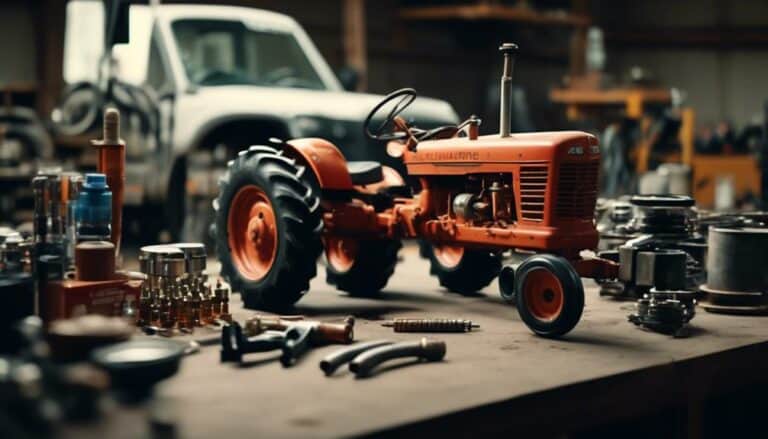Maintaining your ranch's tractor is like tending to a well-oiled machine. Just as you wouldn't neglect the care of a prized horse, your tractor also requires regular attention to keep it running smoothly.
But where do you start? Understanding the key steps in maintaining your tractor is crucial to ensuring its reliability and performance on your ranch.
So, let's break down the essential tasks that will keep your tractor in top condition and your operations running seamlessly.
Key Takeaways
- Regular inspections and checks are essential for maintaining the tractor's performance and preventing potential issues.
- Fluid checks and replacements, such as oil changes and monitoring radiator fluid and DEF levels, help ensure smooth operation and prevent damage.
- Proper cleaning and storage practices, including air filter maintenance, rust protection, and storing the tractor in a dry area, prolong its lifespan.
- Maintenance logging and tracking, using online logs and schedules, help keep track of tasks, set reminders, and ensure thorough maintenance checks are performed.
Conducting Regular Inspections
To ensure optimal performance and safety, regularly conduct thorough inspections of your ranch tractor's key components and systems.
Start by checking the oil levels and quality. Low oil levels or dirty oil can lead to engine damage and reduced performance.
Inspect the tires for any signs of wear, cuts, or embedded objects. Proper tire pressure is crucial for traction and stability.
Next, examine all moving parts for signs of wear and tear. Grease any fittings as per the manufacturer's recommendations to prevent premature failure.
Additionally, inspect the electrical system for loose connections, damaged wires, or corroded terminals.
Routine checks of filters, belts, and hoses are also essential to prevent potential problems.
Ensure that all safety equipment, such as lights and reflectors, is in good working condition.
Checking and Replacing Fluids
When conducting regular inspections of your ranch tractor, it's essential to prioritize checking and replacing fluids to maintain optimal performance and prevent potential issues.
Start by verifying the oil level. Warm up the tractor, remove the dipstick, and check the oil level indicated. If it's low, add oil, and if it's due, change the oil.
Additionally, check the radiator fluid level regularly to detect any serious leaks in the cooling system.
When it comes to hydraulic fluid, change it every 400 hours of use and replace the hydraulic fluid filter.
Keep an eye on the Diesel Exhaust Fluid (DEF) level to ensure it stays within the normal range.
During regular maintenance, don't forget to inspect the oil filter, engine fan blades, and internal parts for signs of wear.
When changing the oil, ensure to use the recommended amount and properly dispose of the old oil through the oil drain.
Cleaning and Properly Storing Your Tractor
Properly cleaning and storing your tractor is essential for preserving its functionality and longevity.
Start by cleaning or replacing the air filters regularly to ensure optimum engine performance.
Additionally, applying a rust prevention coating to susceptible metal surfaces, such as the undercarriage and exposed metal parts, can significantly extend the life of your tractor.
When cleaning your tractor, pay attention to the oil pan and ensure it's free from debris and oil leaks. Regular oil changes are crucial for maintaining the health of your tractor's engine.
Properly storing your tractor includes maintaining the correct tire pressure to prevent flat spots and ensure the tires are ready for use when needed.
To prevent rust, it's essential to keep your tractor in a dry, covered storage area when not in use. A clean, well-ventilated, and dry environment is ideal for preventing corrosion.
Protecting Against Rust
Inspect your tractor for any signs of rust formation during your regular maintenance checks to ensure its longevity and performance. Tractors, like any farm equipment, need maintenance to keep them in top condition.
It's a good idea to keep an eye on areas that are prone to rust, such as the undercarriage, joints, and any scratched or chipped paint. Rust can cause damage to moving parts and help reduce friction, impacting the tractor's efficiency.
To prevent rust, store your tractor in a dry spot to prevent excess moisture, which is a common cause of rust formation. Additionally, consider applying a rust prevention coating to maintain the appearance and performance of your tractor. Regularly monitor the coating for any signs of wear, as rust formation may indicate that the protective coating is wearing off.
Early detection and prevention of rust can significantly extend the lifespan of your tractor, saving you time and money in the long run.
Creating a Maintenance Log
Consider utilizing an online maintenance log to record and track all maintenance tasks performed on your tractor. This will allow you to easily access and update the log from any location, ensuring that all maintenance activities are accurately documented.
Online logs also provide the option to set reminders for future maintenance tasks, helping you stay on top of the tractor's upkeep. When creating the maintenance log, make sure to include the date and description of each maintenance task.
Additionally, utilize online logs and schedules as references to ensure that all necessary tasks are included in the log. Consider creating a checklist to ensure that every component of the tractor is thoroughly checked and maintained.
A comprehensive maintenance log is crucial for prolonging the life of your tractor and preventing potential issues. It will also serve as a valuable resource for identifying signs of wear and addressing any emerging problems early on.
Conclusion
Now that you've learned the key steps in maintaining your ranch's tractor, remember that regular maintenance is like nurturing a growing crop.
Just as you tend to the soil, water, and protect your plants, you must also care for your tractor to ensure its continued productivity and longevity.
By following these maintenance tasks, you can keep your tractor running smoothly and efficiently, just like a well-tended field yielding a bountiful harvest.

